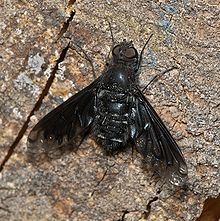Rank Species | Order Diptera | |
 | ||
Similar Anthrax, Hemipenthes morio, Bombylius, Bombylius major, Hemipenthes | ||
Anthrax anthrax, is a species of fly in the family Bombyliidae but unlike for example Bombylius major this species does not mimic a bee or bumblebee. The eggs are flicked by the adult female toward the entrance of the nests of mason bees. After hatching, the larvae find their way into the nests to feed on the bee larva. Anthrax anthrax can be found in May to August throughout mainland Europe, but probably does not occur in Britain. In the Netherlands Anthrax anthrax is a common visitor of insect hotels.
Contents
Description
Anthrax anthrax is a fairly large fly, the body length is 10 mm. The body is black with four white markings at tergum 2 and 3 and two white markings at the end of the abdomen. Tergum 1 is black with tufts of white hairs at the side. These tufts are visible i this picture of a hovering fly.
The wings are mostly black, only the top is transparent. The veins are dark brown. The following picture was overexposed. Due to the brightly lit background the veins are visible.
The newly emerged Anthrax anthrax may be found sitting on a bee hotel. Their body is dull black with more transparent wings.
Behaviour
The females may be found hovering before an insect hotel shooting eggs into the nest entrances of mason bees. An animation is given here.
Every now and then the females are rubbing the abdomen in a place with dust or sand. Dust or sand is necessary to make the eggs less tacky. To this end the females do have a sand chamber. Anthrax anthrax is sometimes seen hovering above a flower, as given in this animation (7.5 times retarded)
